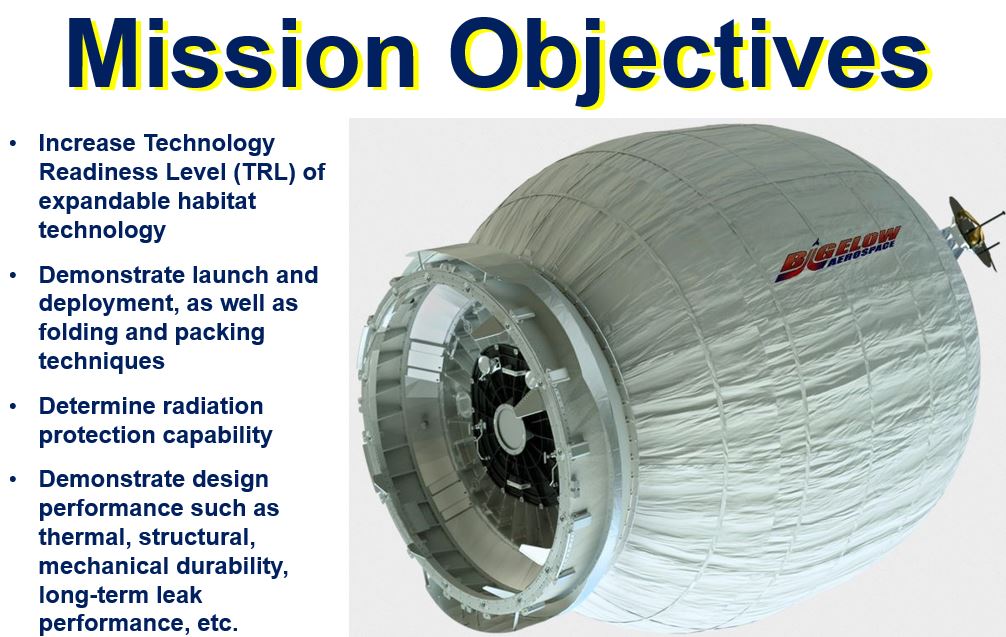An inflatable space module called BEAM – effectively a type of transportable additional living room for astronauts and future space tourists – has been successfully attached to the International Space Station, says the US agency NASA.
BEAM stands for the Bigelow Expandable Activity Module. It is part of an experimental programme developed by Bigelow Aerospace, a US space technology startup firm based in Las Vegas, Nevada, under a NASA contract.
BEAM has been attached to the International Space Station (ISS) to test and validate expandable habitat technology, and see whether it can withstand the hostile environment of outer space.
 BEAM (Bigelow Expandable Activity Module) is now attached to the International Space Station. Over the next two years scientists on the ground and astronauts in the station will carry out tests to determine how effective it is. (Image: blogs.nasa.gov)
BEAM (Bigelow Expandable Activity Module) is now attached to the International Space Station. Over the next two years scientists on the ground and astronauts in the station will carry out tests to determine how effective it is. (Image: blogs.nasa.gov)
BEAM begins its 2-year trial
Scientists at ground control as well as ISS astronauts want to see whether it has potential usage in microgravity and other worlds, such as the Moon and Mars.
Following extraction from the Dragon spacecraft on its 8th resupply mission, the BEAM was installed to the ISS at 5.36 am EDT, on 16th April.
The ISS was flying over the Southern Pacific Ocean at the time of installation. The BEAM will remain attached to the station for a two-year test period.
When the 24-month trial is completed, it will be released from the station and will burn up on reentry into our atmosphere.
Inflatable habitats save money and increase flexibility
NASA, as well as other space agencies across the world, are extremely interested in the concept of habitats that keep astronauts healthy while in space or other planets.
 BEAM was launched in the unpressurized aft trunk compartment of the Dragon spacecraft on the eighth resupply mission to the ISS, SpaceX CRS-8. (Image: bigelowaerospace.com/beam)
BEAM was launched in the unpressurized aft trunk compartment of the Dragon spacecraft on the eighth resupply mission to the ISS, SpaceX CRS-8. (Image: bigelowaerospace.com/beam)
On its website today, NASA wrote:
“Expandable habitats are one such concept under consideration – they require less payload volume on the rocket than traditional rigid structures, and expand after being deployed in space to provide additional room for astronauts to live and work inside.”
In other words, BEAM may offer considerable cost reductions and increased flexibility regarding available rooms for humans during space exploration.
NASA scientists will be especially interested in how BEAM protects humans from solar radiation, flying space debris, and the temperature extremes that exist in space.
Astronauts will enter BEAM four times a year
By the end of May this year, BEAM will be fully inflated with air and expanded to its full size. Astronauts will enter the attached room four times each year and will carry out tests to validate the module’s overall performance and capability.
Are you ready to see the BEAM in space for the first time? pic.twitter.com/3fo2tDY5Ic
— Bigelow Aerospace (@BigelowSpace) April 15, 2016
The creators of BEAM said their number one priority when designing the inflatable space habitat was human safety. For example, if a piece of fast-flying space debris manages to penetrate, BEAM does not burst, but just slowly leaks. It has been designed in a way to preclude any damage to the main station it is attached to, which during this trial period is the ISS.
About Bigelow Aerospace
Bigelow Aerospace was founded by Robert Bigelow in 1998. Mr. Bigelow, a successful business man, owns Budget Suites of America, a hotel chain that caters to long-term budget travelers.
 In 100 years’ time, will Robert Bigelow (above) be remembered as the father of space accommodation? (Image: Wikipedia)
In 100 years’ time, will Robert Bigelow (above) be remembered as the father of space accommodation? (Image: Wikipedia)
He has funded Bigelow Aerospace mainly from profits he gained through his ownership of his hotel chain.
By the end of 2013, he had invested over $250 million into the startup firm. He says he is willing, if necessary, to invest up to $500 million.
Related article: “Crack on International Space Station window from flying debris.”
Video – Attaching BEAM to the International Space Station
This animation shows the Brigelow Expandable Activity Module being extracted and installed on the International Space Station.
